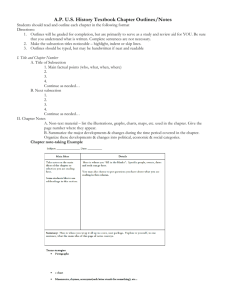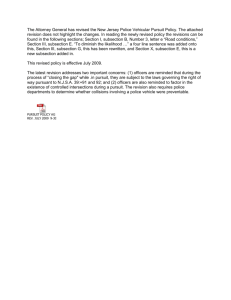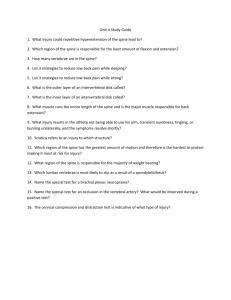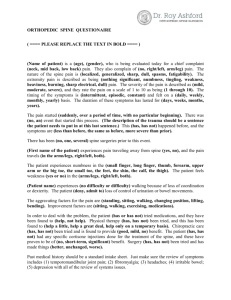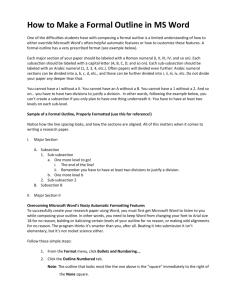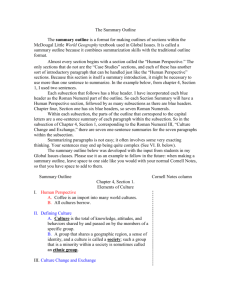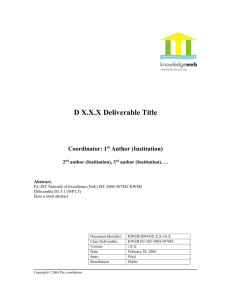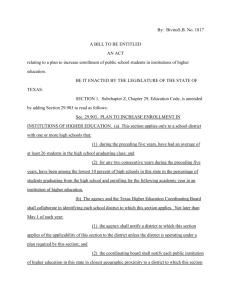“The Spine” and all relevant tasks that must be completed.
advertisement
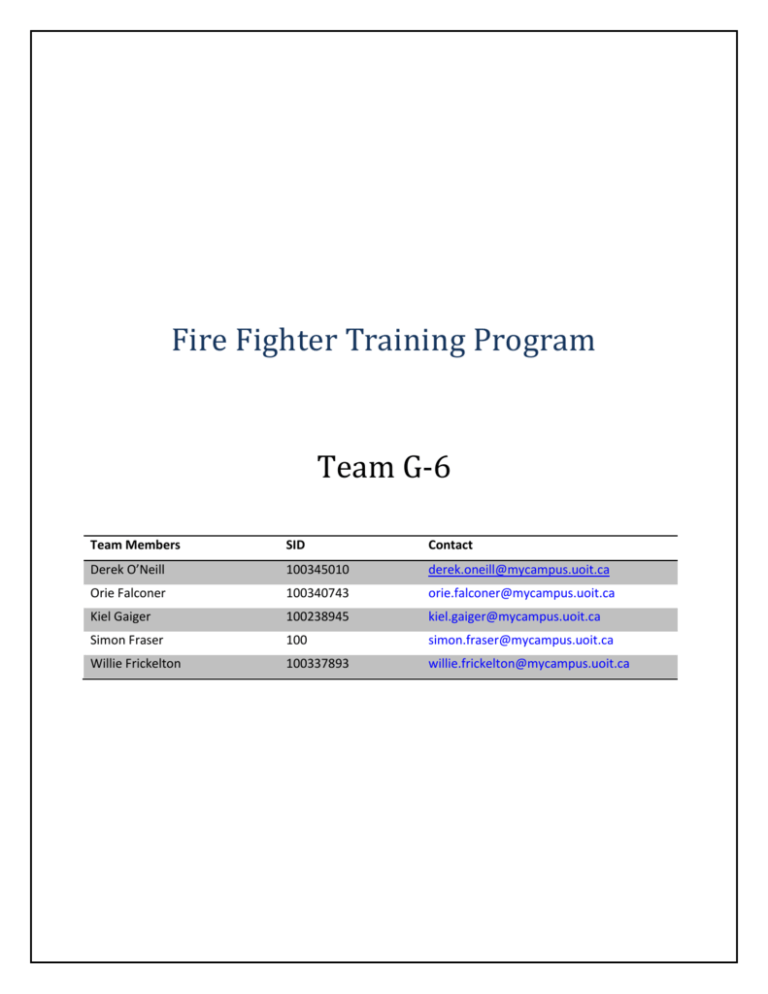
Fire Fighter Training Program Team G-6 Team Members SID Contact Derek O’Neill 100345010 derek.oneill@mycampus.uoit.ca Orie Falconer 100340743 orie.falconer@mycampus.uoit.ca Kiel Gaiger 100238945 kiel.gaiger@mycampus.uoit.ca Simon Fraser 100 simon.fraser@mycampus.uoit.ca Willie Frickelton 100337893 willie.frickelton@mycampus.uoit.ca The Spine TABLE OF CONTENTS SCOPE DOCUMENT ....................................................................................................................................... 3 CHAPTER 1 – THE GAME ............................................................................................................................... 4 SECTION 1.1 – OVERVIEW ......................................................................................................................... 4 SUBSECTION 1.1A – OVERVIEW OF THE GAME .................................................................................... 4 SUBSECTION 1.1B – HIGH CONCEPT ..................................................................................................... 4 SECTION 1.2 – STORY ................................................................................................................................ 4 SECTION 1.3 – AESTHETICS ....................................................................................................................... 4 CHAPTER 2 – TECHNICAL DESIGN ................................................................................................................. 5 SECTION 2.1 – MECHANICS ....................................................................................................................... 5 SUBSECTION 2.1A – GAMEPLAY............................................................................................................ 5 SUBSECTION 2.1B – CONTROL SCHEME................................................................................................ 5 SECTION 2.2 – ASSETS ............................................................................................................................... 5 SUBSECTION 2.2A – RESEARCH AND LIFTING PROCEDURES ................................................................ 5 SUBSECTION 2.2E – SCREENSHOTS ....................................................................................................... 7 SECTION 2.3 – LEVEL CONCEPT ................................................................................................................. 8 SECTION 2.4 – LEVEL DESIGN .................................................................................................................... 8 SUBSECTION 2.4A – LEVEL SECTION 1 .................................................................................................. 8 SUBSECTION 2.4B – LEVEL SECTION 2................................................................................................... 9 SUBSECTION 2.4C – LEVEL SECTION 3................................................................................................... 9 SUBSECTION 2.4D – LEVEL SECTION 4 .................................................................................................. 9 CHAPTER 3 – TECHNICAL ANALYSIS ............................................................................................................ 10 SECTION 3.1 – TECHNOLOGY .................................................................................................................. 10 SECTION 3.2 – MENU SYSTEM ................................................................................................................ 10 SECTION 3.3 – DEVELOPMENT TIME....................................................................................................... 11 SECTION 3.4 – OTHER TECHNICAL CONCERNS........................................................................................ 11 SUBSECTION 3.4A – RISKS ................................................................................................................... 11 SUBSECTION 3.4B – ALTERNATIVES .................................................................................................... 11 SUBSECTION 3.4C – TECHNICAL GOALS AND WISHLIST ..................................................................... 12 SECTION 3.5 – TECHNICAL DESIGN DOCUMENT ..................................................................................... 13 SUBSECTION 3.5A – TOOLS ................................................................................................................. 13 SUBSECTION 3.5B – TECHNICAL ISSUES .............................................................................................. 13 2|Page The Spine SCOPE DOCUMENT TITLE PLATFORM PLAYERS GENRE HIGH CONCEPT GOAL FEATURES 3|Page The Spine PC Single Player Motion Gaming/Simulation Players follow in game instructions to practice proper lifting techniques that can be used to avoid injury in real scenario. Save the city from disasters! Lift dangerous objects to restore peace and justice! -Full body control -Players actions are fully recognized and recreated by in game characters -Teaches the player on proper lifting techniques to avoid real life injuries The Spine CHAPTER 1 – THE GAME SECTION 1.1 – OVERVIEW SUBSECTION 1.1A – OVERVIEW OF THE GAME The Spine is an on rails simulation game in which the player is presented with a situation that requires performing a certain lifting technique to proceed within a particular time span. By following the in game demonstration, the player must recreate the technique with their own body within a reasonable degree of accuracy. If the player does not succeed, they are debriefed on the correct procedure and what injuries can occur if it is used incorrectly before being given another chance. Otherwise the player may continue. SUBSECTION 1.1B – HIGH CONCEPT Players follow in game instructions to practice proper lifting techniques that can be used to avoid injury in real scenario. SECTION 1.2 – STORY Lift Boxer, a mild mannered citizen who was struck by lightning while lifting boxes of uranium. When he arose he found he was gifted with the ability to lift any object as long as he follows regulatory safety procedures…oh and also time manipulation but whatever. This life changing event transformed him into “The Spine”. Using his newfound strength he vowed to help the people of Earth in specific instances in which lifting something might actually help the situation. And also time manipulation, but whatever. When The Spine spots a disaster waiting to happen, he immediately slows the flow of time and springs into action! Can he follow his personal code to not hurt himself in time to save someone else who probably also doesn’t want to get hurt? The choice is yours! SECTION 1.3 – AESTHETICS The art style of the game can be described as cartoony, yet proportionate. The body of the playable character must match with the joints and movements made by the player in order to function properly. The game aims for a humorous tongue in cheek style to help players be more open with using the mo cap suit and make the overall experience more fun. We would like to implement sketchy shading or cell shading to further the effect, but it is on low priority for meeting our personal milestones. 4|Page The Spine CHAPTER 2 – TECHNICAL DESIGN SECTION 2.1 – MECHANICS SUBSECTION 2.1A – GAMEPLAY The Spine is a full body motion game, with the player using a motion capture suit in order to read body movement and translate it to the character model on screen. Levels are broken into 4 sections, representing 4 different scenarios in which lifting objects is required to proceed. Players encounter virtual objects and emulate the proper technique with their bodies in order to lift them. Scoring is based on performance in accuracy (measuring how closely they follow the procedure, within a standard margin of error) and speed. Once a section is cleared the player makes a “Superman” flying gesture in order to proceed to the next section of the level. Each section increases the difficulty and tension of the scenario. SUBSECTION 2.1B – CONTROL SCHEME All in game actions are controlled by body movements while wearing a motion capture suit. SECTION 2.2 – ASSETS SUBSECTION 2.2A – RESEARCH AND LIFTING PROCEDURES This project is meant to educate Fire Fighters on the correct lifting procedures when dealing with heavy equipment, ensuring injury does not occur from misuse or strain. The core lesson for each procedure relies on three principles: 1. The spine stays in a neutral position as long as possible. 5|Page The Spine 2. Tilt the object if possible to distribute weight, and grab in a comfortable position. 3. Lift while keeping the object close to the body. 6|Page The Spine SUBSECTION 2.2E – SCREENSHOTS Screenshots (when applicable) An overview of the level. The numbers indicate the different sections of the level A low polygon car to be used in the game. Will be improved for final submission 7|Page The Spine A low polygon truck to be used in the game. Will be improved for final submission SECTION 2.3 – LEVEL CONCEPT The finalized build of The Spine will consist of one level split into 4 sections, each increasing the difficulty at a reasonable pace. Each section may require the player to lift several objects before they may progress, or multiple “Flying” sections. At each section a ranking will appear to grade the player on how well they are performing. If the performance is below standard, a brief reminder of the core principles is displayed and the player will have to redo the current section. Section 1 2 3 4 Description Debris blocking the street Men trapped under cars Bomb removal Lift a collapsed building SECTION 2.4 – LEVEL DESIGN SUBSECTION 2.4A – LEVEL SECTION 1 The day needs saving, but rescue workers can’t get to where they need to go! It seems the road has been blocked by debris by none of than The Spine’s archenemy – General Guideline! The evil mastermind is off to wreak havoc on the city, but his signature line trail hasn’t faded yet! The Spine must remove the debris before the trail is lost! 8|Page The Spine SUBSECTION 2.4B – LEVEL SECTION 2 The rescue workers have made it to the street and are on the scene! Following the trail has lead to a massive pile up on at the intersection. It appears General Guideline has caused a car accident, and people are trapped underneath the vehicles! The Spine must lift the cars so the rescue team can get the victims to the hospital! There are 5 cars in all. SUBSECTION 2.4C – LEVEL SECTION 3 General Guideline knows The Spine is on his trail, and has left a decoy to slow him down. It’s no big deal really, just a subatomic particle destroying bomb which The Spine is totally invulnerable to… but the people of the city might be somewhat concerned about. It’s wired into a large console, so it will have to be removed delicately before being thrown directly into the sun. SUBSECTION 2.4D – LEVEL SECTION 4 The day is saved, but Guideline is escaping to cause havoc another day. The Spine has one chance to intercept him before he gets away. You know what? This guy? Screw him. He is a jerk. Grab those collapsed buildings and swat him out of the sky! The buildings are extremely heavy, but as long as The Spine doesn’t deviate from the proper procedure he should be able lift them without crushing himself in the process. 9|Page The Spine CHAPTER 3 – TECHNICAL ANALYSIS SECTION 3.1 – TECHNOLOGY The Spine is a 3D training simulation game for PC. The game runs on the Unity Pro engine and is played using a motion capture suit and field, provided by the UOIT Game Development lab. To use the motion capture rig as the controller, we must send data over our network from Arena using C++ to the Unity Pro engine. The OptiTrack Arena Motion Capture Software is what runs on the motion capture rig computer and the computer that will be running the game has the Unity Pro 2.61 engine. All models in the game have been created with Autodesk Maya. Sounds will be recorded on our laptops with a microphone and will be edited using Audacity. SECTION 3.2 – MENU SYSTEM Launch Program Main Menu Play “The Spine” Instructions Instructions Instructions and rules will be listed here As well as a map of the control scheme Return to Main Menu Play Game Exit Terminate Program NOTE: Template 10 | P a g e The Spine SECTION 3.3 – DEVELOPMENT TIME The following table showcases our current timeline for the development of “The Spine” and all relevant tasks that must be completed. Date February 11th February 28th March 14th – 18th April 11th Priority As of this date, Gate #2 and all of its requirements will be completed to the desired specification. Along with the Gate #2 submission, our research report will almost be complete and pending approval we can conduct a study At this point, we will have a fully working game and we can work on tweaking the game mechanics and the rest of the game as necessary to provide a fun and educational experience. Our research report will also be completed by this time. As of this date, we will start our full capstone report and all of our research will be completed. We will also have more tweaking to do to our game to make sure it`s completed to the best of our abilities. This is the due date of the final project. The game and all accompanying reports will be completed and submitted. SECTION 3.4 – OTHER TECHNICAL CONCERNS SUBSECTION 3.4A – RISKS The notable risk that we face with this project is running out of time due to wanting complicated things to be a part of the game. We are trying to avoid such things by making everything as simple as can be at the moment and making it progressively more complicated when we have the time to do so. We would essentially be going down our wish list of things we would like to see in the game. Our other risk is that our game may not be considered “fun”, but rest assured we’ll be trying our best to make it fun for everyone. SUBSECTION 3.4B – ALTERNATIVES Should we fall behind with our deadlines, the best option to keep the team on track would be to drop some of the non-required functionality of the game to focus more on the required items. Doing so will allow us to catch up on some needed work and still make the deadline. Time management is pretty key to this project so we need to make sure that we don’t ever need to do this. We can also use the Kinect sensor on the PC using OpenNI in combination with a couple of other programs. There are some known hacks out there that would allow us to use the Kinect for our game. We are confident we could use this instead of the motion capture rig as there was a team at the Global Game Jam that made a Kinect game in 48 hours. 11 | P a g e The Spine SUBSECTION 3.4C – TECHNICAL GOALS AND WISHLIST Goals: Real time data streaming between Unity and Arena Player character complete Interaction with the game environment Player controls Wish List: Implement all sections of the demo level Functioning menu system 12 | P a g e The Spine SECTION 3.5 – TECHNICAL DESIGN DOCUMENT Base objects Controls Camera Heads up display Menu system Animations Sound Switch level sections Create end game SUBSECTION 3.5A – TOOLS Unity Pro engine v.2.61 OptiTrack Arena Motion Capture Software UOIT Motion Capture Rig Autodesk Maya SUBSECTION 3.5B – TECHNICAL ISSUES Finding the best method to stream data from Arena to Unity (the hardest task to complete) o Tried to make a DLL to do this, found out this is very difficult o As of now, we are using C++ to stream the data over our network 13 | P a g e
